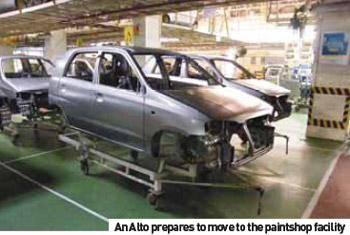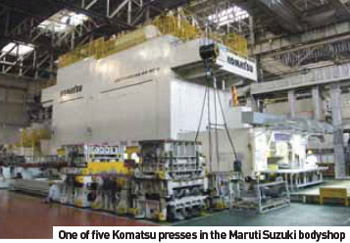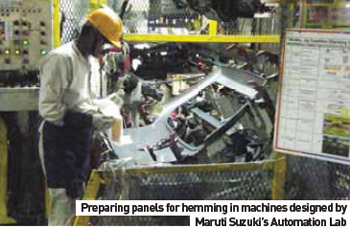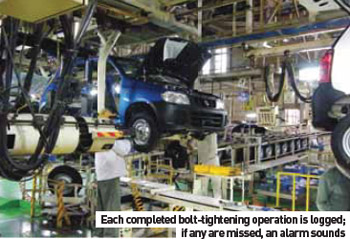Maruti Suzuki has topped India’s JD Power customer satisfaction survey for the ninth year in a row. AMS visits the company’s Gurgaon plant to talk with the company’s manufacturing guru, M.M. Singh, about this, the largest Suzuki manufacturing facility outside Japan.
With an total annual output nudging one million units and a more than 50% market share, Maruti Suzuki is India’s largest carmaker. At the head of this production behemoth is M.M. Singh, Managing Executive Officer, who in addition to overseeing all aspects of vehicle production and production engineering projects is also head of the company’s logistics operations. In his twenty-five years with Maruti Suzuki, Singh has instituted a number of efficiency initiatives to increase vehicle production numbers, effectively doubling output without any major additions to the workforce. His success, he says, is primarily down to analysing production processes and, together with his line staff, cutting out wastages.
 “In 1992, when I became department head of paintshops, we first looked at where the bottlenecks were in the production process. In the paintshops, where we used to paint 460 bodies every day, we gradually went through a process of Kaizens and improvements and we now paint 700 bodies per day (in each paintshop). We did this without any major investment; it was a major turning point for the company.”
“In 1992, when I became department head of paintshops, we first looked at where the bottlenecks were in the production process. In the paintshops, where we used to paint 460 bodies every day, we gradually went through a process of Kaizens and improvements and we now paint 700 bodies per day (in each paintshop). We did this without any major investment; it was a major turning point for the company.”
The paintshop was an appropriate place to start implementation of the new efficiency drives, as it was there that Singh gained his first managerial experience with Maruti Suzuki; this, after holding an equipment maintenance position since his 1983 start with the carmaker.
“Doing this (machine maintenance), I got to know about most of the machines in all the shops, pressing, body, paint and assembly. So I was conversant with all the equipment. I was paintshop manager for six years. It was an interesting start, as I still believe that paint is a key area of automotive manufacturing.”
In 1990, Maruti switched from anodic to cathodic electronic deposition painting. It was, says Singh, an important change. “Maruti brought in a totally new technology. It was to prove important, as in ’93 we started sending the 800 (now the current Alto) to Europe. In India, you could sell what you produced but Europeans were at that time more knowledgeable about the product. The change was a real challenge for me because first I had to understand and learn the system and then move on to the idea of improvement.”
While not underestimating the importance of understanding the latest technologies across the production arena, Singh believes that a fundamental way to improve manufacturing efficiencies is to have an on-going conversation with the people building cars on the line.
“When I was managing the paintshop, it was almost a oneto- one contact. Once you become a general manager, this is not possible, so we developed our own communication system. Once a quarter, we have a meeting with all our employees, four or five hundred at a time, together with all the supervisors, engineers and managers.
“We incorporate the feedback from these meetings into how we will organize our future production. We put forward what we need to accomplish and the workers tell us what they think we can do to achieve those goals. Further, they talk about what they want from me, as the top manager.”
According to Singh, incorporating these comments essentially commits line technicians to following their own recommendations, while Singh himself is bound to his own set of commitments as to what he needs to accomplish as senior manager.
He goes on to point out that communicating the agreed plans for the upcoming year presents its own set of problems, as it is of vital importance that the information be delivered in an easily-understandable format.
“The message can be lost in communication,” says Singh. “When you communicate with people on the line, it has to be a very simple message. You have to cut the jargon and complex wording in order to help people understand. Most problems occur because people don’t understand each other, which can be traced back to poor communication strategies.”
Further to the models currently produce by Maruti Suzuki, which include the Swift, SX4, Dzire and A-Star (new Alto, Pixo) at the Manesar plant and the Maruti 800, Alto, Wagon R, Zen Estilo, Gypsy (Samurai), Omni and Versa at the Gurgaon plant, the company is currently in the process of building a design capability for the development of a new model. “Our engineers are being trained on live projects in SMC Japan to learn the skills required for such work,” says M.M. Singh, Managing Executive Officer.
What features do car buyers in India look for?
“In India, we have large families, so space is very important. The back seat must offer a lot of space. Even with small cars, you have to consider that buyers might have a driver. In Europe and other markets, this generally not a concern outside the luxury market. In India, anyone who can afford a new car might also have a driver. So the rear seat must be very comfortable.
“Further, the suspension must suit Indian roads. A lot of roads are quite rough and the suspension must accommodate both surfaced and unsurfaced roads. The ground clearance must be higher, even with passenger cars, to avoid underbody damage.
“Perhaps the most important factor for buyers here is mileage and cost. Financing and vehicle cost are one thing, but running costs come straight out of the owner’s pocket and buyers want to keep those expenses to a minimum. The cabin has to look nice, it has to be comfortable, but fuel efficiency sells. Buyers will make a purchase decision based on the running costs for 10 or 20,000 kilometres and the anticipated servicing costs. To meet this demand, we recently launched the 19.5km/litre K-Series engine in the new A-Star.”
The importance of defining roles
According to Singh, 80% of the work at Maruti Suzuki involves planned line jobs, where roles are clearly defined; people know what they are going to be doing tomorrow.
 The other 20% of the workforce are encouraged to develop their own systems. It is a fine balance, when based in the context of the all-encompassing Maruti Suzuki production management system (PMS).
The other 20% of the workforce are encouraged to develop their own systems. It is a fine balance, when based in the context of the all-encompassing Maruti Suzuki production management system (PMS).
“In manufacturing today, a lot of roles are overlapping,” explains Singh. “We try to redefine ourselves to fit specific roles. The problem with that is overlap naturally creates a built-in system of checks and balances, so we have to build in our own checks. For example, you say to a worker ‘this is your area to maintain’. But how do supervisors define how he is doing his job? We have developed a system that requires the worker to complete an activities update, including suggested improvements. Safety, quality, productivity, cost – the four pillars on which our production ethos is based – are all charted using a single document, covering both daily and weekly activities and targets. You have to remember, I didn’t decide how to set this up, our people developed this system.”
Singh goes on to note that while line workers have limited scope for extended planning, line supervisors are expected to incorporate planning activities with their documentation of production processes. It is an opportunity to shape production that grows with each successive level of management. It is important though, says Singh, to follow through on agreed plans, though he is aware that this could create difficulties later on.
“There are certain things I know I can make decisions on there and then. But if I don’t know, I will take it away and communicate my decision at a later time.”
Beyond appropriate communications with his team and employees, Singh is an advocate of managerial delegation. “I think it is of critical importance for the general manager of a production facility to delegate. Transfer of responsibility is very important. You must build trust - and trust comes with the transfer of trust. People taking ownership is key to improving the quality of our cars. Before I was general manager, I used to ask myself, ‘why is this not being done, why has this (problem) not been addressed?’. As a solution, I have tried to build a system that allows transparency, where people from all levels can find answers to their queries.” Further, Singh believes that mutual respect is required to maintain trust. “Everybody wants to be respected.
Whether you’re a line worker, supervisor, manager or director, your approach will determine what kind of response you get from an individual.”
Harmonizing labour and automation
In a country like India, it could be argued that the case for automation could never be won, taking into account the availability and cost of labour. But for a company that produces a vehicle every 25 seconds, automation is not a choice, it is a necessity. But that does not mean it has been easy to achieve a working mix between the two.
“Our plants are at a level of 86% automation,” says Singh. “Initially, it was difficult to achieve a balance between automation and labour. People are concerned about automation; if flexible automation is introduced, does it mean job losses? To counter this I talked to people, I explained to them that the automation was to help reduce your work and build a better product.”
To promote working within an automated environment, Singh initiated ‘walk is not work’. “Customers will not pay for walking, they will only pay for the value built into the product,” explains Singh. “So we introduced a programme to reduce the number of steps each technician would take to complete a task.” Having completed audits of technicians across the plant covering the number of steps taken to retrieve and fit a given component, there followed a complete review of station processes. Says Singh. “It was my guarantee, my challenge, to fulfil the promise that after an eight-hour shift, our people would be less fatigued.”
While being well-accepted by the workforce, the programme also benefited production. In a move that characterizes Singh’s commitment to reducing wastage, less walking meant more time to fit components, which translated to an immediate improvement in final production numbers.
“Automation improves productivity and quality, but I think how we take care of our people also improves quality.
If your people are worried, the product quality will suffer. As managers, we must follow through on what we promise to our people; if you commit, you must deliver. I won’t always commit immediately, but once I have, I will follow through 100%.”
Maruti Suzuki saves on the cost of added automation by developing equipment in-house. For example, AGV units that take vehicle doors from lineside to the kitting area were developed by the company’s own Automation Lab, whose logo is visible on machinery across the plant.
“If I was to outsource similar projects, my cost would increase by 20%. And further, you lose technical ownership of the machinery. Mechanical engineers, when they visit the line, always ask, “What can I do?” This is an opportunity to let these people design. This freedom, it motivates the engineers, especially the younger ones, who need that excitement. It gives them the opportunity to design something of their own and see that in action on the line.”
New engineers, though, need to build a working knowledge of the production process to accurately assess what is needed and what is feasible. Rather than wait for these engineers to gain hands-on experience, Maruti Suzuki has launched a technical training centre with 13 training modules. Says Singh, “Basically, we offer a chance for people to upgrade their knowledge. This is beyond Kaizen. This is studying the electrical systems, the mechanical systems, to understand more about the current production process.”
India is a market where there is a notoriously high turnover of skilled labour. Beyond salary incentives, M.M. Singh claims that the training centre is another way to retain staff, simply by building and maintaining interest in the work.
According to Managing Executive Officer M.M. Singh, there are three key elements that carmakers outside the country can take from the Maruti Suzuki experience:
1. “If you take care of your in-house customers (your employees), then this will ensure that your outside customer is also taken care of. It’s not just paying salaries, you have to look at each and every aspect of an employee’s relationship with the company.”
2. “Local conditions have to be taken into account in order to sustain your market. The (production) system that is successful in Japan or Europe may not necessarily going to work in India, or vice versa. To successfully make changes, you have to clearly understand what is expected from you as an employer. You have to fully understand the requirements of the worker.”
3. “At the end of the day, your product is going to be successful if you’re addressing the aspects that are important to the customer.”
The Maruti Suzuki factory at Gurgaon, thirty kilometres south-west of New Delhi, features three fully-flexible lines with 21 separate shops, arranged to allow production to flow around bottlenecked areas. The new Manesar plant, a further thirty kilometres from Gurgaon, features a single line arranged in the ‘straight line’ concept, with press, paint and assembly shops all located under one roof, with raw steel entering and finished vehicles exiting the plant.
 According to S.G. Mani, Assistant General Manager for Manufacturing Strategy and Development, Maruti Suzuki uses a variety of steel suppliers. “Our suppliers are located in India, South Korea and Japan. We purchase from any of these areas, based on quality levels and the best wholesale price. At the Gurgaon facility, our stamping shops have five major presses, from Komatsu, and one blanking machine running at sixty strokes per minute. All major panels are made on-site, with some smaller parts delivered by suppliers.
According to S.G. Mani, Assistant General Manager for Manufacturing Strategy and Development, Maruti Suzuki uses a variety of steel suppliers. “Our suppliers are located in India, South Korea and Japan. We purchase from any of these areas, based on quality levels and the best wholesale price. At the Gurgaon facility, our stamping shops have five major presses, from Komatsu, and one blanking machine running at sixty strokes per minute. All major panels are made on-site, with some smaller parts delivered by suppliers.
One of the joint-venture companies (located at the Gurgaon facility) supplies the chassis.”
Both facilities feature paint operations from Taikisha, though the two plants use dissimilar painting methods. Says Mani, “In Gurgaon, the basecoat is applied then baked, followed by the intermediate and top coats and another baking process.
The final finishing coat is then applied and baked. In Manesar, it is different, we have a three-coat and one-bake system. In India, dust is a big challenge in regards to painting and this has to be constantly managed.”
In addition to the dust, energy delivery poses another problem. Instead of depending on the local grid for a consistent power supply for the paintshops, the Gurgaon and Manesar plants have their own power stations delivering power throughout.
From weld, which features robotics by Kawasaki, Fanuc and Motorman, the car bodies move through paint and into the assembly shop. At Gurgaon, where many of the seven models in production can be built on any of the three lines, bodies move through the assembly shop on conveyors from NKC. All finished vehicles undergo rolling road, emissions and water ingress tests before dispatch.
There are a variety of quality control elements built in to the production line. Over two hundred ‘quality gates’ are placed at strategic points, where inspectors check for problems with the parts, vehicles or the system. The gates provide feedback to the source station regarding observed defects. Generated tickets prompt a supervisor to check the vehicles on the line to confirm quality, while also making sure there is no replication of the problem. “We get instant feedback,” says Mani, “so people can immediately act upon that information.”
Other quality checks include ‘pika pika’ or foolproof dynamic bolt systems. Within a takt time of 75 seconds, workers must tighten sixteen wheel bolts per vehicle. For each action, the system recognizes the completion of an individual tightening operation, reducing the number of anticipated movements per vehicle. If a bolt is missed, an incomplete job total triggers an alarm, giving the operator an opportunity to fix the problem before the line is halted.
In addition, a vehicle tracking system follows each body through the assembly process. As there can be multiple models on the same line, when the vehicle is presented in-station, the system indicates from which rack the worker should take the necessary part. Sensors record if the part is taken and if not, the line is automatically stopped. “This way,” explains Mani, “we ensure that the right part is picked up in the right way.” Mani goes on to say that Maruti Suzuki is in the process of implementing a multi-training programme, by which workers in one station can also operate the systems in earlier and later stations, defined as ‘+1 and -1’.
As defects are recognized, vehicles are repaired on the production line, with only a small number being directed to a rework park at the end of the line. Once the repair is made, the car is then reintroduced to the line to complete the assembly process.
“With the multi-station skilling programme and other quality initiatives, we hope to reduce the level of warranty costs. And less problems mean less cars taken off the line for repairs. Currently we have a direct pass (defect-free) production total of 91%. This means that out of about 2,500 units per day, there is an average of 67 units that require repair work.”

“As market demands keep changing, these requirements need to be addressed in terms of production numbers,” says S.G. Mani. “We have a system, the Maynard Operations Sequence Technique, to calculate the volume mix and produce multi-level production systems.
 “For Maruti Suzuki, this is a new way of thinking about working. We take a video (of a station), do a process study, conduct a basic time study, and enter this into the software to set benchmark times for production processes. Given a required production volume, we can calculate how many people need to be deployed on the line. We have done the same thing with our Maruti Production Systems (MPS).
“For Maruti Suzuki, this is a new way of thinking about working. We take a video (of a station), do a process study, conduct a basic time study, and enter this into the software to set benchmark times for production processes. Given a required production volume, we can calculate how many people need to be deployed on the line. We have done the same thing with our Maruti Production Systems (MPS).
Enter the data and the software can set where operators need to be positioned and how many parts need to be supplied – the results are shared with our lineside delivery teams. In one go, we get all the information needed to create a production plan, which is updated every fifteen days. It reduces the shuffling of people and materials.”
Using the MPS, Maruti Suzuki has reduced the total time per vehicle by 49%, resulting an increase from 350,000 to 700,000 upa at the Gurgaon facility – without any major capital investment or labour costs.
Further, Maruti Suzuki has reduced line set up time from seven to a minimum of one and a half days. In the same way that vehicles can switch production lines to avoid bottlenecks, technicians can also switch areas to meet production needs, facilitated by the multiple training system which teaches procedures in various stations.
“We have fluctuating demands from marketing, above the 15-day production plan, and these requirements need to be addressed in terms of production numbers. We use the system to calculate volume mix and produce multi-level production systems.
“Depending on market demands, we set a fixed volume requirement every two weeks (marketing requirements are above and beyond this, requiring only minor adjustments), using a lean ordering system. Our requirements are handed over to the Tier suppliers and they in turn plan their schedules around what we need to have delivered.”
Maruti Suzuki uses another in-house tool, the Indexed Cost Per Vehicle system, to calculate cost per vehicle. “When you’re building a low-cost vehicle with a higher volume, the cost per vehicle will always seem to be low, although an actual improvement may not have been realized,” explains Mani. “Using the ICPV, we benchmarked the cost of producing an Alto, a common model across all three lines, and the entire cost per vehicle is calculated on those figures. Each model being made can then be equated with how many Altos it takes to produce.”
Through the implementation of 251 cost-saving programmes, Maruti Suzuki anticipates saving Rs123m (£1.75m) between March ‘08 and March ‘09, with a planned 5% improvement in savings each successive year.


































